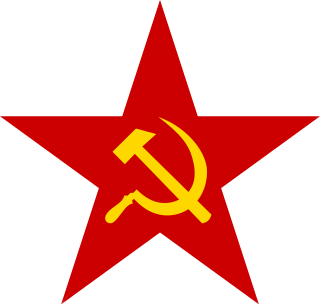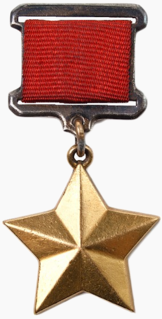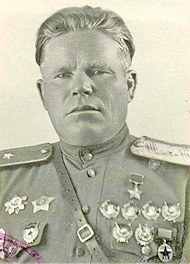
Ivan Nikitich Konev was a Soviet major general during World War II and a Hero of the Soviet Union. Konev led the 3rd Guards Airborne Division through most of the war and was awarded the title Hero of the Soviet Union for his leadership of the division during the Jassy–Kishinev Offensive. Postwar, Konev continued to serve in the Soviet Army and became the deputy commander of multiple army corps.

Alexey Ivanovich Polosin was a Red Army sergeant, who was posthumously a Hero of the Soviet Union. He was posthumously awarded the title for his actions in the Battle of the Dnieper. Polosin was reported to have killed three German officers during a reconnaissance mission and 26 soldiers while repulsing a German counterattack.
Mikhail Grigoryevich Solovyov was a Red Army Lieutenant and posthumous Hero of the Soviet Union. Solovyov was posthumously awarded the title for his leadership of a company during the Battle of the Dnieper, in which he reportedly killed 31 German soldiers. Solovyov was killed in action during the Battle of the Dnieper.
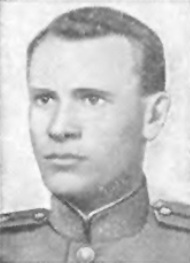
Mikhail Nikiforovich Linnik was a Soviet Army captain and Hero of the Soviet Union. Linnik was awarded the title Hero of the Soviet Union and the Order of Lenin for his actions during the Lublin–Brest Offensive in September 1944.
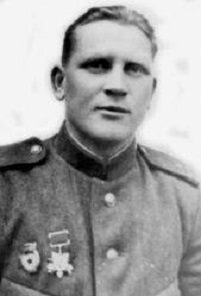
Dmitry Sergeyevich Gusev was a Red Army senior lieutenant and Hero of the Soviet Union. Gusev was awarded the title Hero of the Soviet Union and the Order of Lenin for his actions during the Lublin–Brest Offensive. At the time of the action, he was a platoon commander in the 134th Rifle Division.
Viktor Andreyevich Turbin was a Red Army Junior Lieutenant and posthumous Hero of the Soviet Union. Turbin was posthumously awarded the title Hero of the Soviet Union and the Order of Lenin for his actions while leading a platoon during Operation Bagration in summer 1944. His platoon reportedly held a bridgehead on the Drut River against numerically superior German troops until the crossing of the remainder of Turbin's regiment.
Nikolai Anisimovich Nagibin was a Red Army soldier and posthumous Hero of the Soviet Union. He was awarded the title Hero of the Soviet Union and the Order of Lenin for his usage of a machine gun to hold a bridgehead over the Oder during the Vistula–Oder Offensive in January 1945.
Arkady Yegorovich Chepelev was a Red Army Starshina or sergeant major and Hero of the Soviet Union. He was awarded the title for ferrying weapons and ammunition to troops in the Dnieper bridgehead and repelling counterattacks during the Battle of the Dnieper. Chepelev continued to fight in combat and served with the 167th Rifle Division during the Lvov–Sandomierz Offensive and Battle of the Dukla Pass, among others. He was demobilized postwar and returned to Voronezh, working as a mechanic in an aircraft factory.

Konstantin Mikhailovich Kabanov was a Soviet Air Force Colonel and Hero of the Soviet Union. After graduating from flying school in 1944, Kabanov was sent to the front and made 27 attacks on Danzig. He reportedly made a total of 103 attack sorties during the war flying Ilyushin Il-2 attack aircraft, for which he was awarded the title Hero of the Soviet Union. Postwar, Kabanov continued to serve in the Air Force and became a test pilot and later engineer at the Air Force Research Institute.

Dmitry Ivanovich Rodin was a Red Army junior lieutenant and Hero of the Soviet Union. Rodin was awarded the title for his leadership of a platoon during the Lublin–Brest Offensive, during which he was seriously wounded for the sixth time. As a result of this, Rodin spent the rest of the war in the hospital and was discharged in April 1945. Postwar, he worked as an engineer in the Ministry of Railways design and research institute.
Grigory Samoylovich Kabakov was a Ukrainian Red Army lieutenant and Hero of the Soviet Union. Kabakov was awarded the title for leading his company during the Battle of the Dnieper in September 1943, where he reportedly killed 60 German soldiers.
Dmitry Timofeyevich Kamolikov was a Red Army sergeant and a Hero of the Soviet Union. Kamolikov was awarded the title for his actions in the Budapest Offensive during the crossing of the Tisza, when he reportedly led the repulsion of 12 counterattacks. He was seriously wounded in the battle and was discharged. Postwar he worked as an engineer at a factory equipment supply factory.

Ochil Kadyrov was an Uzbek Red Army soldier and a posthumous Hero of the Soviet Union. Kadyrov was posthumously awarded the title for reportedly using his machine gun to enable the crossing of the Narew by his regiment in September 1944. He was seriously wounded and died of his wounds on 13 March 1945.

Ivan Andreyevich Kabalin was a Soviet Army junior lieutenant and Hero of the Soviet Union. Kabalin was a sergeant and a squad leader in a mortar company during the Battle of the Dnieper and was awarded the title Hero of the Soviet Union for reportedly killing 250 German soldiers while repulsing counterattacks. Kabalin stayed in the army postwar and retired in 1955 as a junior lieutenant. He worked as a turner and then director of a carriage works after graduating from a railway college.
Nikolai Petrovich Kabalin was a Red Army starshina or sergeant major and Hero of the Soviet Union. Kabalin was awarded the title for his actions during the Dnieper–Carpathian Offensive. Kabalin reportedly destroyed a German machine gun, enabling his battalion to establish a bridgehead. In early May 1944 he was seriously wounded when a bomb hit his dugout and was later discharged for medical reasons. Postwar, he worked at the Gorky automobile plant.
Pavel Antonovich Kabanov was a Red Army senior sergeant and Hero of the Soviet Union. Kabanov was awarded the title for suppressing German firing positions during the crossing of the Western Dvina in the Vitebsk–Orsha Offensive. Postwar, he worked at the Central Aerohydrodynamic Institute.
Vasily Grigoryevich Kabanov was a Red Army major and Hero of the Soviet Union. Drafted into the Red Army in 1930, Kabanov fought in the Battle of Lake Khasan and the Battles of Khalkhin Gol as a tank company Politruk. After being seriously wounded in fighting around Leningrad, he took refresher courses at the Red Army Military Academy of Mechanization and Motorization. Kabanov returned to the front in January 1945 as a tank battalion commander and fought in the Vistula–Oder Offensive, where his battalion helped take Skierniewice. For his leadership, Kabanov was awarded the title Hero of the Soviet Union. He was mortally wounded during the Battle of Berlin.
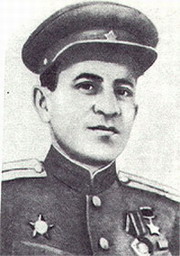
Mammad Ali oglu Maharramov was an Azerbaijani Red Army lieutenant and a Hero of the Soviet Union. Maharramov fought in the Winter War after being drafted into the Red Army in 1941. He fought in World War II from 1941 and was awarded the title Hero of the Soviet Union on 22 February 1944 for leading his squad in reportedly killing 50 German soldiers during the Battle of the Dnieper, among other actions. After the war, Maharramov was chairman of the village council and a kolkhoz.
Abbas Shahbaz oglu Guliyev was an Azerbaijani Red Army captain and Hero of the Soviet Union. Guliyev was awarded the title on 21 February 1945 for his leadership of his battery during the Lublin–Brest Offensive. Guliyev's battery reportedly helped repulse counterattacks in the Puławy bridgehead. Postwar, Guliyev was discharged from the army. He was deputy Minister of Education of the Nakhchivan Autonomous Republic and secretary of the Presidium of the Supreme Soviet of the republic.
Nikolai Alexeyevich Vychuzhanin was a Red Army junior lieutenant and a Hero of the Soviet Union. Vychuzhanin was awarded the title on 15 January 1944 for his actions in crossing the Dnieper in eastern Belarus, in which he commanded a 37th Guards Rifle Division machine gun platoon. Vychuzhanin's platoon, according to his Hero of the Soviet Union citation, repulsed 20 counterattacks, killing up to 400 German soldiers. After the war, Vychuzhanin left the army and worked in agriculture.
